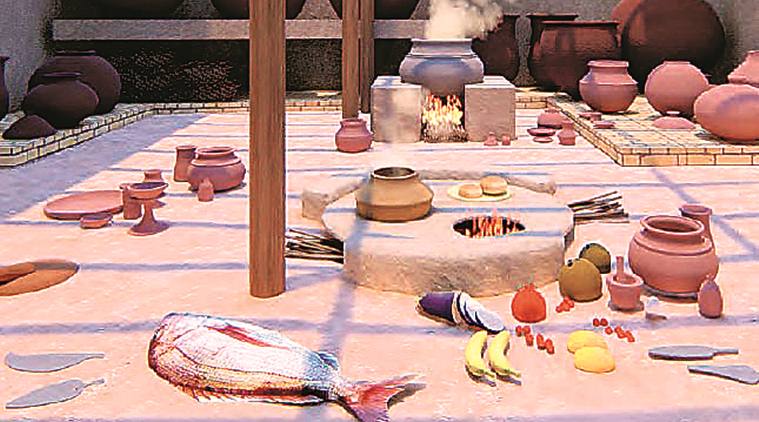- India
- International
Harappans would have scoffed at modern advocates of vegetarianism
The animals that Harappans kept and consumed is rather well known. What is less known is the range of wild animals enjoyed by them and the fact that these contributed greatly to their diet.
 A promotional image for Historical Gastronomica. (File) With an impressive variety of meats, fish, and fowl, the cuisine of the Harappan city dwellers would even today be considered a gourmand’s delight.
A promotional image for Historical Gastronomica. (File) With an impressive variety of meats, fish, and fowl, the cuisine of the Harappan city dwellers would even today be considered a gourmand’s delight.
Harappan food was rich in all kinds of fleshy delights. Indeed, with an impressive variety of meats, fish and fowl, the cuisine of the Harappan city dwellers would even today be considered a gourmand’s delight.
Before giving a graphic description of the nourishing non-vegetarian fare that they delighted in consuming, perhaps I should mention how food remains are studied. Within the material culture that has survived, there is the garbage of everyday life found at archaeological sites around the production and consumption of food — vast quantities of broken and discarded pottery, chewed and charred animal bones, sundry cereals and seeds of fruits and implements used in producing and processing food. Such artefacts are now studied through scientific techniques that can even indicate whether stone tools were used to cut meat or wild grass, and whether grinding stones mashed mangoes or cereals.
In India, unfortunately, we don’t get direct evidence of a meal, that is, of what ancient people consumed at a particular time and day because this comes from the stomachs and the excreta of past people. Neither of these have survived in archaeological contexts here.
Opinion | Harappan meat-eaters, Lutyens’ vegetarians
Occasionally, a single sample on a site will yield large amounts of material. At the Harappan city of Surkotada, charred lumps of carbonised seeds were discovered from an earthen pot. Two of the charred lumps yielded nearly 600 specimens, an overwhelming majority of which were from wild plants. Only about 7 per cent were identified as being of cereals. The cereals were millets, wild and cultivated, wild grasses, nuts, and weeds. This cannot give clues to the relative importance of different cereals because the sample only reflects a moment in time.
Plant remains from Harappan sites reveal the entire repertoire, from cereals and lentils to fruits and vegetables, and even the spices used. Recognising grains is easy and has been done for nearly a century since the discovery of Mohenjodaro and Harappa because burnt cereals survive rather well and sometimes also leave an imprint on clay. Among vegetables and fruits, it is usually their seeds that are identified. More recently, the archaeologist Arunima Kashyap has recovered and identified at Harappan Farmana (in rural Haryana), starch granules from pots, grinding stones, and teeth, showing the processing, cooking and consumption of mangoes, bananas and garlic. What was left over after the household ate was evidently fed to their animals since the same starch granules were scraped off the teeth from cattle remains found there.

The first thorough investigation of ancient animal remains from an archaeological site anywhere in the Indian subcontinent was done at Mohenjodaro, published in 1931 in the first excavation report of the city. Written by Colonel R B Seymour Sewell and B S Guha, no less than 37 species were identified. There were domesticated and wild animals and included a considerable frequency of humped cattle, pig, and fish. Apparently, gharials and turtles, remains of which in many cases have been burnt, indicate that such animals formed part of the food of that city. Since then, as a 1994 article by P K Thomas and P P Joglekar revealed, there have been some two dozen Harappan sites whose animal remains are reported. Interestingly, cattle bones account for more than 70 per cent of the bones and, in fact, any Harappan site where bones have been found, without exception, has yielded cattle bones. Evidently, while cattle were used for agricultural operations and as draught animals, their meat was vastly enjoyed. Mutton was the other food that was commonly consumed as were pigs.
Animal teeth have also been studied to understand when the victims were killed. At Harappan Oriyo Timbo (in Gujarat), nearly 15,000 animal bones were recovered and annular rings accurately fixed the age and season of death of fauna. The microscopic annuli on a dental substance known as cementum was carefully assessed. What these revealed was that cattle, sheep and goat were slaughtered from March to July. Usually, very young animals were not killed, and slaughtering was most common in cattle samples at 30 months and 18 months in sheep/goat. Mature animals bones were also very common which underlines that adult animals were valued for their productive capacity.
The animals that Harappans kept and consumed is rather well known. What is less known is the range of wild animals enjoyed by them and the fact that these contributed greatly to their diet. Various types of deer and antelopes were hunted, and many varieties of birds, turtles, fish, crabs and molluscs were found as Thomas and Joglekar point out, “in the kitchen refuse”. We also know that ancient Punjabis at the city of Harappa enjoyed marine catfish.
Explained | What did the Harappan people really eat? A fact check
Among wild animals, from Gujarat’s Kuntasi and Shikarpur, bones of wild ass with cut marks and evidence of charring underlines that they were hunted for food. Gujarat’s Harappan sites, as Shibani Bose’s just published book on Mega Mammals in Ancient India reveals, also show the presence of rhinoceros. It is animals that are normally eaten which find their way into archaeological deposits and that is likely to be the reason why these bones are so commonly found. In the case of Nausharo in Baluchistan, rhino bones were found in a hollow along with trash. What Bose also points out is the consumption of rhino meat in historical India and that texts on Indian medicine like the Caraka Samhita attribute definite health benefits to it.
Some scriptures did frown on or had misgivings about killing and consumption of animals. The Satapatha Brahmana, an ancient Indian religious text that forms part of the Vedic corpus, is full of fine detail about sacrificial ritual, and the eater of meat is said to be eaten in his next birth by the animal killed. Regardless of these occasional scriptural impediments, the general picture is of an ancient populace not just carnivorous but eagerly so.
All this should give pause to modern advocates of vegetarianism who want to make ancient Indians in general and Harappans in particular appear to be like them. Harappans would most certainly have scoffed at such attempts, even as they chomped through chunks of roasted cattle and pig.
Also read | Time-travelling to a Harappan kitchen is politically fraught in a country at war over food habits
This article first appeared in the print edition on February 25, 2020 under the title ‘A wider platter’. The writer is professor of history at Ashoka University.
EXPRESS OPINION
Must Read
More Explained
Apr 23: Latest News
- 01
- 02
- 03
- 04
- 05







































